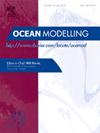区域和区域分层流动能量学研究的大力一致的局部APE预算
IF 2.9
3区 地球科学
Q2 METEOROLOGY & ATMOSPHERIC SCIENCES
引用次数: 0
摘要
由于它允许可逆和不可逆过程之间的严格分离,可用势能(APE)的概念已成为紊流分层流体研究的核心。在海洋模拟中,它是中尺度海洋涡流和热盐湍流混合参数化的基础。然而,如何将APE理论一致地应用于局部或区域子域一直是一个长期的混乱来源,因为全球定义的洛伦兹参考状态进入了APE的定义,而浮力在这些情况下通常被认为是没有意义的。实际上,这通常通过引入启发式的“局部”形式的APE密度来弥补,该密度仅依赖于特定区域的参考状态,可能与全局洛伦兹参考状态显著偏离。本文认为,只有将APE密度的局域形式定义为APE密度的精确平均/涡动分解的涡动APE分量,才能一致地描述跨尺度的能量传递。为此,我们提出了一个新的物理上更直观、数学上更简单的框架。由此定义的涡流APE密度对全局洛伦兹参考状态的依赖性比平均APE弱得多,这与物理直觉一致,但与现有的启发式局部APE形式具有不同的结构。我们的框架建立了一个严格的物理基础,将参数化的能量转移与分子粘性和扩散耗散率联系起来。我们通过讨论湍流密度通量的标准平流和扩散参数化的能量学含义来说明它的潜在用途,这揭示了海洋模式中数值不稳定性的潜在新来源。本文章由计算机程序翻译,如有差异,请以英文原文为准。
Energetically consistent localised APE budgets for local and regional studies of stratified flow energetics
Because it allows a rigorous separation between reversible and irreversible processes, the concept of available potential energy (APE) has become central to the study of turbulent stratified fluids. In ocean modelling, it is fundamental to the parameterisation of meso-scale ocean eddies and of the turbulent mixing of heat and salt. However, how to apply APE theory consistently to local or regional subdomains has been a longstanding source of confusion due to the globally defined Lorenz reference state entering the definition of APE and of buoyancy forces being generally thought to be meaningless in those cases. In practice, this is often remedied by introducing heuristic ‘localised’ forms of APE density depending uniquely on region-specific reference states, possibly diverging significantly from the global Lorenz reference state. In this paper, we argue that across-scale energy transfers can only be consistently described if localised forms of APE density are defined as the eddy APE component of an exact mean/eddy decomposition of the APE density, for which a new physically more intuitive and mathematically simpler framework is proposed. The eddy APE density thus defined exhibits a much weaker dependency on the global Lorenz reference state than the mean APE, in agreement with physical intuition, but with a different structure than that of existing heuristic localised APE forms. Our framework establishes a rigorous physical basis for linking parameterised energy transfers to molecular viscous and diffusive dissipation rates. We illustrate its potential usefulness by discussing the energetics implications of standard advective and diffusive parameterisations of the turbulent density flux, which reveals potential new sources of numerical instability in ocean models.
求助全文
通过发布文献求助,成功后即可免费获取论文全文。
去求助
来源期刊

Ocean Modelling
地学-海洋学
CiteScore
5.50
自引率
9.40%
发文量
86
审稿时长
19.6 weeks
期刊介绍:
The main objective of Ocean Modelling is to provide rapid communication between those interested in ocean modelling, whether through direct observation, or through analytical, numerical or laboratory models, and including interactions between physical and biogeochemical or biological phenomena. Because of the intimate links between ocean and atmosphere, involvement of scientists interested in influences of either medium on the other is welcome. The journal has a wide scope and includes ocean-atmosphere interaction in various forms as well as pure ocean results. In addition to primary peer-reviewed papers, the journal provides review papers, preliminary communications, and discussions.
 求助内容:
求助内容: 应助结果提醒方式:
应助结果提醒方式:


